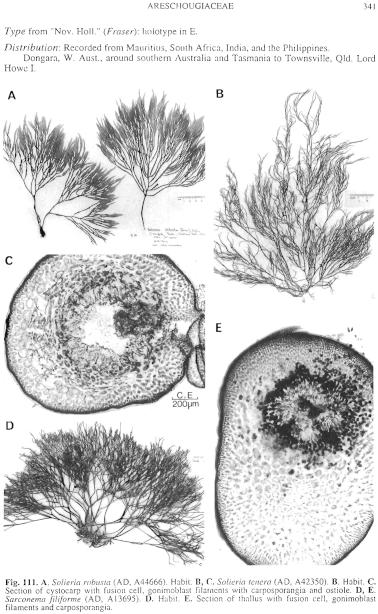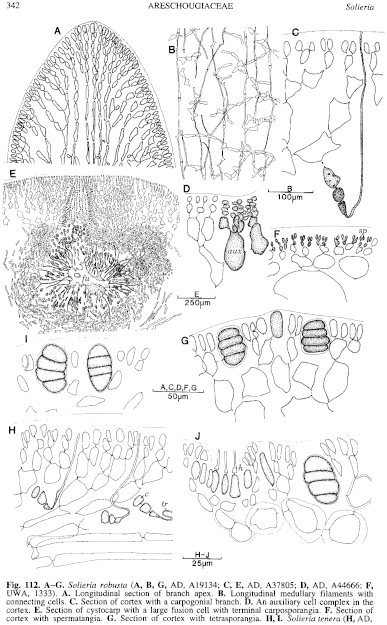|
|
|
|
|
|||||||||||
|
Electronic Flora of South Australia Species Fact Sheet
Phylum Rhodophyta – Class Florideophyceae – Order Gigartinales – Family Areschougiaceae
Selected citations: Gabrielson & Hommersand 1982a: 31, figs 2–4, 13–20, 24, 25, 28, 29, 31, 39, 40–45.
Thallus (Fig. 111B) medium red-brown, 10–20 cm high, much branched irregularly with numerous laterals of varying length, branches terete, 1–1.5 mm in diameter below, decreasing to 200–400 µm in diameter in branchlets, basally constricted and tapering gradually to acute tips. Holdfast small, probably fibrous; epilithic on pebbles or shells. Structure multiaxial with 6–10 apical cells, each subapical cell cutting off a periaxial cell with successive periaxials more or less orthostichous at first but this arrangement soon obscured, developing a medulla of the 6–10 prominent apical filaments (Fig. 112H), each becoming (6–) 10–20 µm in diameter, interlinked by slender cells or rhizoidal filaments (especially prominent at bases of laterals), and a pseudoparenchymatous cortex 4–6 cells thick, inner cells ovoid and 40–80 µm in diameter, outer cells 4–7 µm in diameter and L/D 1.5–2. Rhodoplasts discoid, few to numerous per cell.
Reproduction: Sexual thalli dioecious(?); non procarpic. Carpogonial branches (Fig. 112H) 3-celled, borne on inner cortical cells and directed inwards with reflexed trichogynes. Gonimoblasts directed radially from a large, central, fusion cell, branched and with terminal clavate carposporangia 10–18 µm in diameter. Cystocarps (Fig. 111C) immersed in the medulla, swelling the branch, with enveloping tissue of ovoid cells, ostiolate. Spermatangia cut off from surface cortical cells.
Tetrasporangia (Fig. 112I) scattered in the outer cortex, sub-basally attached, 40–50 µm long and 24–30 µm in diameter, zonately divided.
Type from the West Indies; lectotype in Herb. Agardh, LD, 34480 (see Gabrielson & Hommersand 1982a, p. 41).
Selected specimens: Power Station outfall, Hobsons Bay, Vic., 3 m deep (Watson, 1.v.1972; AD,
Distribution: Western Mediterranean; western Europe and tropical West Africa; North Carolina, U.S.A. to southern Brazil.
In southern Australia, from Port Phillip, Vic.
Taxonomic notes: A42350). Williamstown, Vic., on rocks in sand, 3 m deep (Kraft, 19.i.1975; MELU, K5109; J. Lewis, 7.iv.1975; MELU, 21966; and J. Lewis, O'Brien & Kraft, 7.i.1976; MELU, 22019).
These collections of S. tenera from the inner part of Port Phillip Bay, Vic., agree well with this species as known and described from the West Indian region. They are probably adventives which may not have spread or established themselves in the area.
References:
GABRIELSON, P.W. & HOMMERSAND, M.H. (1982a). The Atlantic species of Solieria (Gigartinales, Rhodophyta): their morphology, distribution and affinities. J. Phycol. 18, 31–45.
WYNNE, M.J. & TAYLOR, W.R. (1973). The status of Agardhiella tenera and Agardhiella baileyi (Rhodophyta, Gigartinales). Hydrobiologia 43, 93–107.
The Marine Benthic Flora of Southern Australia Part IIIA complete list of references.
Publication:
Womersley, H.B.S. (14 January, 1994)
The Marine Benthic Flora of Southern Australia
Rhodophyta. Part IIIA, Bangiophyceae and Florideophyceae (to Gigartinales)
Reproduced with permission from The Marine Benthic Flora of Southern Australia Part IIIA 1994, by H.B.S. Womersley. Australian Biological Resources Study, Canberra. Copyright Commonwealth of Australia.
Illustrations in Womersley Part IIIA, 1994: FIGS 111B, C, 112H, I.

Figure 111 enlarge
Fig. 111. A. Solieria robusta (AD, A44666). Habit. B, C. Solieria tenera (AD, A42350). B. Habit. C. Section of cystocarp with fusion cell, gonimoblast filaments with carposporangia and ostiole. D, E. Sarconema filiforme (AD, A13695). D. Habit. E. Section of thallus with fusion cell, gonimoblast filaments and carposporangia.

Figure 112 enlarge
Fig. 112. A–G. Solieria robusta (A, B, G, AD, A19134; C, E, AD, A37805; D, AD, A44666; F, UWA, 1333). A. Longitudinal section of branch apex. B. Longitudinal medullary filaments with connecting cells. C. Section of cortex with a carpogonial branch. D. An auxiliary cell complex in the cortex. E. Section of cystocarp with a large fusion cell with terminal carposporangia. F. Section of cortex with spermatangia. G. Section of cortex with tetrasporangia. H, I. Solieria tenera (H, AD, A42350; I, MELU, 21966). H. Longitudinal section with medullary filaments and cortex with three carpogonial branches. I. Section of cortex with tetrasporangia. J. Sarconema filiforme (AD, A13695). Section of cortex with young and mature tetrasporangia and a hair tuft. [A–G after MM-Thein & Womersley 1976.]

|
Email Contact: State Herbarium of South Australia |

|